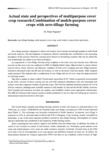Actual state and perspectives of multipurpose cover crop research: Combination of mulch-purpose cover crops with zero-tillage farming
JIRCAS international symposium series
| ISSN | 13406108 |
|---|---|
| 書誌レコードID(総合目録DB) | AA1100908X |

本文フルテキスト
intlsymp-13_103-106.pdf122.14 KB
Zero-tillage practices, designed to reduce soil erosion, have become increasingly popular in both North and South America. The development of numerous effective herbicides has contributed to the increasing prevalence of this practice. However, resource-poor farmers in developing countries who can not afford the cost of herbicides are unable to use these techniques.
An experiment in zero-tillage farming using sorghum as the main crop and mucuna bean (Mucuna pruriens) as the cover crop was conducted in 2003 on Ishigaki Island, Japan. Mucuna bean is a green manure used in Africa, South America and Okinawa. Adoption of both cover cropping and zero tillage practices resulted in decreased water run-off and soil erosion, as well as decreased weed dry matter, while sorghum yield increased. This indicates that a combination of zero tillage and use of cover crops has major potential as a farming system.
This idea is similar to what is called "Conservation Agriculture (CA)" which, as generally recommended by the FAO, consists of direct sowing into the soil with minimum disturbance and with maximum soil surface cover that comprises residues of previous crops. The FAO has initiated extension projects for CA in African countries, although more scientific research is still needed. In Asia and the Pacific islands, however, FAO research and extension activities are modest, and feasibility studies await appropriate introduction. The JIRCAS Okinawa Sub-tropical station is ideally positioned to act as a base for setting up an extensive international research network on this topic.
An experiment in zero-tillage farming using sorghum as the main crop and mucuna bean (Mucuna pruriens) as the cover crop was conducted in 2003 on Ishigaki Island, Japan. Mucuna bean is a green manure used in Africa, South America and Okinawa. Adoption of both cover cropping and zero tillage practices resulted in decreased water run-off and soil erosion, as well as decreased weed dry matter, while sorghum yield increased. This indicates that a combination of zero tillage and use of cover crops has major potential as a farming system.
This idea is similar to what is called "Conservation Agriculture (CA)" which, as generally recommended by the FAO, consists of direct sowing into the soil with minimum disturbance and with maximum soil surface cover that comprises residues of previous crops. The FAO has initiated extension projects for CA in African countries, although more scientific research is still needed. In Asia and the Pacific islands, however, FAO research and extension activities are modest, and feasibility studies await appropriate introduction. The JIRCAS Okinawa Sub-tropical station is ideally positioned to act as a base for setting up an extensive international research network on this topic.
| 作成者 | Dr. Fujio Nagumo |
|---|---|
| 著者キーワード | zero-tillage farming multi-purpose cover crop weed control conservation agriculture |
| 公開者 | Japan International Research Center for Agricultural Sciences |
| オンライン掲載日 | |
| 号 | 13 |
| 開始ページ | 103 |
| 終了ページ | 106 |
| 言語 | eng |
